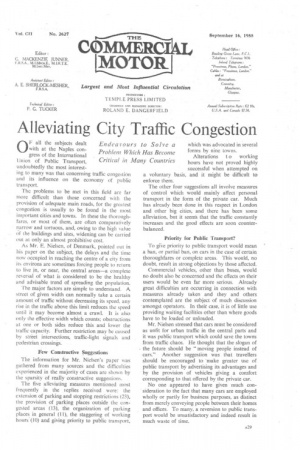Alleviating City Traffic Congestion
Page 31

If you've noticed an error in this article please click here to report it so we can fix it.
OF all the subjects dealt with at the Naples con gress of the International Union of Public Transport, undoubtedly the most interesting to many was that concerning traffic congestiOn and its influence on the economy of public transport.
The problems to be met in this field are far more difficult than those concerned with the provision of adequate main roads, for the greatest congestion is usually to be found in the most important cities and towns. In these the thoroughfares, or most of them, are often comparatively narrow and tortuous, and, owing to the high value of the buildings and sites, widening can be carried out at only an almost prohibitive cost.
As Mr. E. Nielsen, of Denmark, pointed out in his paper on the subject, the delays and the time now occupied in reaching the centre of a city from its environs are sometimes forcing people to return to live in, or near, the central areas—a complete reversal of what is considered to be the healthy and advisable trend of spreading the population.
The major factors are simple to understand. A street of given width can normally take a certain amount of traffic without decreasing its speed, any rise in the traffic above this limit reduces the speed until it may become almost a crawl. It is also only the effective width which counts; obstructions at one or both sides reduce this and lower the traffic capacity. Further restriction may be caused by street intersections, traffic-light signals and pedestrian crossings.
Few Construefive Suggestions The information for Mr. Nielsen's paper was gathered from many sources and the difficulties experienced in the majority of cases are shown by the sparsity of really constructive suggestions.
The five alleviating measures mentioned most frequently in the replies received were: the extension of parking and slopping restrictions (23), the provision of parking places outside the congested areas (13), the organization of parking places, in general (11), the staggering of working hours (10) and giving priority to public transport, which was advocated in several forms by nine towns.
Alterations t o working hours have not proved highly successful when attempted on a voluntary basis, and it might be difficult to enforce them, The other four suggestions all involve measures of control which would mainly affect personal transport in the form of the private car. Much has already been done in this respect in London and other big cities, and there has been some alleviation, but it seem 's that the traffic constantly increases and the good effects are soon counterbalanced.
Priority for Public Transport?
To gi've priority to public transport would mean a ban, or partial ban, on cars in the case of certain thoroughfares or complete areas. This would, no doubt, result in strong objections by those affected.
Commercial vehicles, other than buses, would no doubt also be concerned and the effects on their users would be even far more serious. Already great difficulties are occurring in connection with measures already taken and they and others contemplated are the subject of much discussion -amongst operators. In their case, it is of little use providing waiting facilities other than where goods have to be loaded or unloaded.
Mr. Nielsen stressed that cars must be considered as unfit for urban traffic in the central parts' and it was public transport which could save the towns from traffic chaos. He thought that the slogan of • the future should be "moving people instead of cars." Another suggestion was that travellers should be encouraged to -make greater use of public transport by advertising its advantages and by the provision of vehicles giving a comfort corresponding to that offered by the private car.
No one appeared to have given much consideration to the fact that many cars are employed wholly or partly for business purposes, as distinct from merely conveying people between their homes and offices. To many, a reversion to public transport would be unsatisfactory and indeed result in much waste of time.




































































































